
March 4th 2008
You lucky people, two diary entries in quick succession. A student cancelled this evening, so I have time to write this. Today, we went to the First Rabbit Festival at Shirahata Hachiman, the local shrine. The name comes from the day on which it is held; today was First Rabbit, or at least first rabbit in March. In Japan, traditionally, the days are named after the twelve animals of the Chinese zodiac (among three or four other things), and the rabbit is one of those animals. The festival, which is the spring festival, is held on the first day of the Rabbit in March. And that was today.
This is the only one of the major festivals at Shirahata-san I had't attended yet. Two years ago I didn't know when the day of the rabbit was, so I missed it. Last year, Yuriko had an appointment at the clinic, to I couldn't go. This year, however, there was nothing to stop us going; no lessons, and even nice weather. So we put Mayuki into the carrying harness, and I carried her to the shrine.
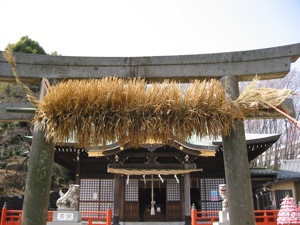 The snake on the torii.
The snake on the torii.
The first part of the ceremony is putting a giant straw snake on the entrance torii, as you can see in the pictures. In the west, there might be concerns that this was a phallic symbol. In a Shinto shrine, you can be fairly sure it isn't, because when they want a phallic symbol, they use a giant phallus. Snakes have been closely associated with the kami all the way back. In fact, there's one early legend in which the kami just seem to be snakes. It's entirely possible that this is exactly what they were; Shinto kami are not necessarily purely spiritual things. Mount Fuji is arguably a kami, for example. (This makes the question "do you think the kami exist?" less informative than "do you think God exists?". I believe that Mount Fuji exists. I also believe that there are snakes in Japan. But that's probably not quite what the questioner would mean.) The other association is of snakes with water, and that is probably the association here, as water is very important for rice cultivation, and the snake is made of rice straw and vegetables.
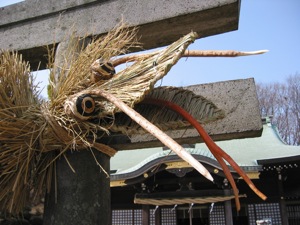 The snake's face.
The snake's face.
The snake stays on the torii until the summer festival, so by the time it comes down it's looking rather sorry for itself. At the moment, though, he looks quite cheerful, as you can see from the pictures. He also looks a lot like a bottle brush. I'm fairly sure he isn't supposed to be symbolic of that, though.
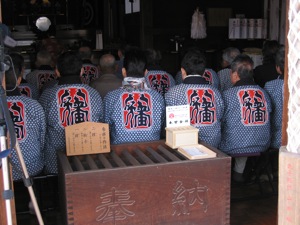 The Ujiko seated in the shrine, with the happi design clearly visible.
The Ujiko seated in the shrine, with the happi design clearly visible.
The next bit was a ceremony in the shrine building. The Ujiko, the formally-registered parishioners of the shrine, all sat in ranks, wearing their happi coats. These are common at festivals in Japan, and the design on the back indicates the group to which you belong. The general pattern is fairly universal, so you go by the rear design. The design on these says "Hachiman", which is the name of the kami in the shrine, but the two strokes of "hachi", at the top, are in the shape of doves. This is because the dove is the animal particularly associated with Hachiman; a similar pattern appears in various places around the shrine. (I'm sure I've mentioned this before.)
There are now two priests at the shrine, the Guji, or chief priest, and his son, who is the one who did our Hatsumiyamairi and is clearly being trained up to succeed his father. Hereditary shrine priesthoods are fairly common, particularly in the smaller shrines. There are even special "crash course" training programs for people who suddenly have to take over the family shrine. Anyway, both priests participated in this ceremony, as it is one of the more important ones of the year. The basic format was the same as any shrine festival. It started with the ritual purification of the attendants and the items to be used, which was done by the younger priest.
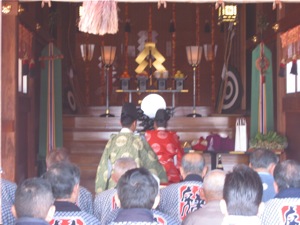 The festival in progress.
The festival in progress.
The chief priest then went to kneel in the centre of the shrine, and said "ooooooOOOOOOOoooooo". I'm not entirely sure what this was about; one of the shrine staff did announce it, but I didn't quite catch it. It wasn't a word I'm familiar with, which means listening to the sounds and working out what the kanji probably are. I failed. Then the norito was read, asking the kami to support the people in the area throughout the year; the original aim of the festival is to pray for a good harvest. After that, the chief priest said "oooooooOOOOOOOOooooooo" again, and then (I think...) the Ujiko offered tamagushi; little twigs of Sakaki with paper attached. That ended that part of the festival. The next bit took place outside the shrine.
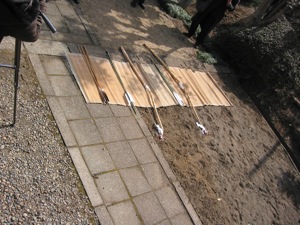 The bows and arrows, lined up ready on the ground. The green arrows are the bamboo ones.
The bows and arrows, lined up ready on the ground. The green arrows are the bamboo ones.
You may have noticed something looking a lot like a target at the back of the shrine in the picture of the ceremony. It was a target; the next part of the ceremony involved shooting at it, from not very far. In origin, this was, apparently, a way of foretelling what they year would be like. I rather hope that that's not what it's for now, or at least that it doesn't work.
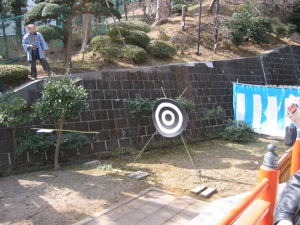 An arrow on its way in the general direction of the target.
An arrow on its way in the general direction of the target.
First, the two chairmen of the Ujiko were supposed to shoot simple arrows made from bamboo from crude bows, with the shide (paper strips like lightning) tied on. Those are the bows you can see in the picture. However the string on one came off as soon as he tried to draw it, so that bit of the ceremony was abandoned. Instead, the bamboo arrows were shot from proper bows. First, they were shot at the ground, twice. Then they were shot at the target. The archers were quite successful in hitting the ground, less so in hitting the target.
Then two young boys, maybe about three and five years old, dressed all in white in Japanese style, came up to shoot arrows. They were accompanied by (I think) their grandfathers, who were also dressed Japanese style, but in blue. The boys did not actually shoot the arrows themselves, but stood there while the adults did. I gather, from conversations with the shrine family, that children that age can't actually make the bows fire. Looking at the bows, I can certainly believe it.
After they'd finished, various Ujiko took turns shooting at the target. They were not generally very accurate, which is why I hope that this is not an accurate way of forecasting the coming year... The younger priest also tried, but he dropped the arrow on his first attempt. The chief priest gave him some advice, and then he was able to hit the target a couple of times.
The whole thing took about an hour, and there weren't that many people there, probably due to it being a weekday morning. It was very interesting, and quite a lot of fun; I hope I'll be able to go again next year.
After we came back, I put all the Doll Festival dolls away. That took quite a while; first getting them put away in their boxes, and then getting the boxes put away in the cupboard. However, everything went into the boxes (I'm very glad that I took lots and lots of photographs while I was taking them out), and everything went into the cupboard (that was just luck). It did mean that I didn't get an enormous amount of work done today, but you can't have everything.